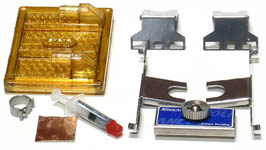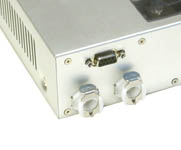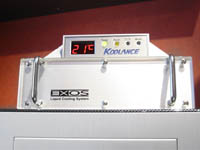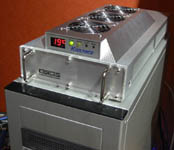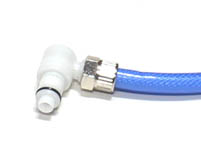It has been a while since we had a glimpse at cooling, with the latest being a roundup of a number of waterblocks. Today, we shall continue in the spirit of water cooling and we are now looking at a complete system from Koolance – it’s external aluminum solution aptly named Exos-Al. Is is a completely external box with a radiator, pumps and a reservoir which you put on top of the PC. The tubes are connected to a waterblock in the computer. It won’t get much easier than this. The radiator is in aluminum, but the waterblock is made of gold-plated copper.
It has been a
while since we had a glimpse at cooling, with the latest being a roundup of
a number of waterblocks. Today, we shall continue in the spirit of water cooling
and we are now looking at a complete system from Koolance – it’s external
aluminum solution aptly named Exos-Al. Is is a completely external box with
a radiator, pumps and a reservoir which you put on top of the PC. The tubes
are connected to a waterblock in the computer. It won’t get much easier than
this. The radiator is in aluminum, but the waterblock is made of gold-plated
copper.
It should be
interesting to see how this system performs, since it looks like Koolance
has thought of a lot of things. It has a little different solutions on some
problems which are frequently occuring in connection with water cooling. To
keep the weight down there’s an aluminum radiator, and to avoid corrosion
while retaining good performance for the waterblock it is made of massive
gold-plated copper with a plexi top. Instead of including one single large
pump, there are two small. You will find out why this is a good choice if
you read on.
|
Specifications: Koolance Exos-Al
|
|
|
The Exos unit
|
|
|
Size (cm)
|
18.4
x 9.5 x 47 |
|
Weight
|
1.8
kg |
|
Est. Price
|
€220
excl. VAT |
|
Radiator
|
|
|
Construction |
Lamellae
|
|
Fittings
|
6
mm (OD) |
|
Fans
|
|
|
Amount
|
3
|
|
Manufacturer
|
Ruilian
Science |
|
Model
|
RDH8025B
|
|
Dimensions
|
80
x 80 mm |
|
CFM
|
28
@ 12V |
|
Speed
|
3000
RPM @ 12v |
|
Pump
|
|
|
Manufacturer |
Koolance
|
|
Model
|
R-PMP01
|
|
Flow
|
1l/min
|
|
Amount
|
2
|
The first thing
noticed in the specifications is that the radiator is made out of aluminium.
This means that it may never be combined with waterblocks of copper, since
the aluminium parts will gradually corrode. Fortunately, all other blocks
are made out of aluminium or gold-plated copper, so if you stick to Koolance
parts there will be no problems. Furthermore, you may see that the radiator
is of a lamella type and not a tube radiator which is the most common type
in complete watercooling kits. Lamella radiators are generally better than
their tube-based counterparts. The cooling of the radiator is done by three
80 mm fans manufactured by Ruilian Science. Since the radiator is wider than
80 mm, the fans are equipped with fan tunnels so that the airflow is spread
all over the radiator. Very nice done by Koolance – not many manufacturers
think of this.
|
|
|
One thing that
is unique to Koolance is the pump system. Instead of settle with one pump,
the company’s used two pumps in a serial connection. The reason for this is
partly to get the system safer – if one pump would break the system can live
with one – but the main reason is to get a higher water pressure. Thanks to
this, you may connect several additional waterblocks to the system without
loosing much performance.
The tubing’s
diameter is 6 mm (inside), and according to Koolance this is the best tube
diameter for the system. In other words, thicker tubing will not improve performance.
The pumps give, according to Koolance, a flow of about 1 liter per minute
with waterblock and radiator installed.
The electronics is divided into three parts and the main part is a controller
card which resides in the external unit. This card does all the tasks: fan
regulation, temperature surveillance etc. A circuit board handles the display,
and a last one acts interface towards the computer.
|
|
|
The CPU block |
The only waterblock
that comes with the unit is the CPU block, and bears the model name CPU-200.
It is the procursor to the first block CPU-100 and number of improvements
have been made. First of all, the total size of the block has been increased
and has a such become a better heat buffer. Secondly, Koolance has increased
the area of the water in two ways; partly by adding more pins and partly by
using a basic maze design.
|
|
|
These improvements
will probably do a lot for the performance. We’ll have a look at how good
it performs later in the review. The block fits on both Socket A and P4 systems
and is made out of pure copper, plated with 21 carat gold. Thanks to the gold-platening,
it will not corride since gold is a more precious metal than aluminium.
The bundle is
rich but not exaggeratedly so. We get the following parts: an interface card,
about 2 meters of extra strong tubing, a D-sub cable, a power-on cable, one
meter clear tube for internal use, a CPU temperature probe, a cable to start
the PSU without starting the computer, quick-fittings, rubber feet, velcro
stripes, one rubber hose and a premixed heat transferring medium.
|
|
|
The interface
card is mounted in a free PCI slot and fulfills two functions. It has two
spring equipped holes which are used as a tube entrance in addition to a connection
place for internal electronics. It is a very smart solution, which Corsair
actually uses in its HydroCool. In addition to transmitting the power-off
signal and the temperature sensor’s value to the external unit, there are
also two fan connections on the circuit board. The voltage on those are regulated
by the Koolance unit, so a higher temperature on the waterblock means that
the fans will spin faster. The connection outwards is a 9 pin D-sub contact.
It comes with a cable that’s connected between the external unit and the interface
card.
Koolance encloses
two different sorts of tubing; one robust and armored tube for out-of-the-case
usage and one regular clear PVC tube for internal use. I personally think
it’s a strange decision not to use the armored tubing internally as well.
|
|
|
The cable that
is used to short the power supply is geniously designed. This way you can
start the watercooling and look for any leaks without risking the components
in the computer. In resemblance to HydroCool, Exos is equally equipped with
the genius quick-fittings which enable you to easily disconnect the external
unit from the computer without having to empty the system of fluid. These
fittings are invaluable for an external system and simplify things heavily.
A very strange
thing with the unit is the way the heat transferring medium is enclosed in.
The normal way is that you get a little bottle with stuff which subsequently
is mixed with destilled water. Koolance sends a big bag with everything ready-mixed.
This means more weight and a risk for leakage; my bag was leaking when I received
the unit. Fortunately though, the bag is encapsulated in a transparent bag
which collected everything that had come out, but the solution still come
out as pretty stupid. All in all, there’s approximately 6dl of fluid.
The front panel |
Of course, there
are interaction facilities for the unit. This is done via the front panel
on Exos. It consists of two LEDs, two buttons and a LED display. One button
is used for selecting the unit with which temperatures are displayed – Celsius
or Farenheit – and the other one sets the fan voltage depending on the temperature
of the built-in thermistor. There are three settings which all are showed
in the graph below. This gives the user the possibility to set noise/performance
to his or her liking.

If the heat level
reaches 50 degrees C the unit starts beeping, and at 53 degrees C the computer
shuts down. Note that it is not the CPU temperature it watches, but only the
sensor under the waterblock. The CPU temperature is probably somewhere between
10 and 20 degrees C higher.
|
|
The LED display
normally shows the temperature on the enclosed thermistor, but it can also
display error codes and may e.g. indicate that the thermistor is broken, the
temperature is too high, and more. The two LEDs that reside on the front indicate
if the pumps are on and if the fans are in acceleration mode, i.e. gets a
voltage over 45 %.
The external
unit is built by a base of aluminum and a fan holder of silver-colored plastic.
The fan holder accommodates the three 80 mm fans, and has matching metal grills
bolted with countersunk screws. On the side, there is some text saying "Koolance"
and this time it’s not the company’s logotype that is ruining the design.
On the front there is also the LED-display with buttons and LEDs, red LEDs
in the display, a green and a yellow to Power and Acceleration mode. For a
unit at this price level, Koolance should have chosen different-colored LEDs
– after all, green and orange aren’t the most sought-after.
|
|
|
The front is
also adorned by a thick piece of plexi glass with handles and an Exos print.
It’s hard to catch the effect on a picture, but you’ll have to believe me
when I say that it is looking very luscious. Since the fans are blowing air
upwards there is underpressure in the box itself. This is remedied by a hole
on the side where air can move freely into the box. On the back, there is
a hollowed-out piece for the reservoire with the pumps. Here you can control
the water level and fill with water.
|
|
|
|
To get inside
of the unit is very complicated. It’s not that every user wants to, but the
more experienced user would probably like to disassemble it to clean the radiator
from dust and such. When you get inside of it you can see a well-organised
interior: it is very airy and everything except the reservoir is properly
fastened. The radiator is screwed to the case with big trays and rubber gaskets
so that the pressure won’t damage the lamellae. Circuits, hoses and output
fittings are orderly fastened, but the reservoir remains loose in the box.
The cause of this is found on the top where there are cuttings that fits the
cut hole which makes it able to be held there. It stands on rubber plates
to avoid any damage at transporting.
|
|
| Installation |
The installation
is well-covered by the manual: many pictures and minute instructions on how
to connect the system to the computer. The first step is to screw the quick-fittings
onto the blue tubing, after you’ve cut these to adequate lengths. The tubes
are then connected to the back of the external unit with the black D-sub cable
that is used for signal and current transfer to the unit. Subsequently, the
interface card is mounted into a free PCI slot, the tubes are slipped on the
proper holes and the D-sub cable is connected.
|
|
|
The next step
is to mount the waterblock on top of the processor, and thanks to the brilliant
construction, it is easily done on both Socket 478 and Socket A. First, you
choose the right side tray for the middle tray with the screw and these are
pushed in on the sides. Then you just have to lay it on the socket, push the
trays in or out until they lock themselves to the motherboard and screw the
screw until it clicks. The tubes are easily mounted using the included tube
clamps. Now the cooling wiring is complete, and there are only a few steps
left.
|
|
|
You just have
to fill the external unit with fluid, connect the power internally and short
the power supply unit. The latter is done by disconnecting the ATX cable from
the motherboard, and the green and black are connected using the included
shorting cable. The pumps will now start but not the computer, which keeps
the damage of any leakage minimal. If no leakage is discovered you just have
to connect the ATX cable again and start the system like you usually do.
|
The
test system |
|
|
Hardware
|
|
| CPU |
XP1700+
|
| Mainboard: |
Abit NF7-S 2.0
|
|
Software
|
|
|
Temp.reading:
|
MotherBoard
Monitor 5.3.4.0 |
|
Definitions |
|
|
Idle:
|
1 hour
with all processes except
the
essentials turned off |
| Load: |
The
temperature after
2 hours of
Prime95 |
To get a better
test result I have modified my mainboard to show on-die-temperatures. This
means that the temperature is catched on the processor itself and not in the
socket. This provides you with a higher but more exact value. Unfortunately,
I don’t have any other watercooling products to use as reference, so the only
thing I have to compare with is an ordinary heatsink. 45/100 % refers t the
voltage to the fans.
|
Temperature levels unclocked 1700+ @ 1.65V |
||||||||||||||||||||||||||||||
|
||||||||||||||||||||||||||||||
|
||||||||||||||||||||||||||||||
|
Temperature levels clocked 1700+ @ 2270MHz (2700+) 1.92V |
||||||||||||||||||||||||||||||
|
||||||||||||||||||||||||||||||
|
||||||||||||||||||||||||||||||
As you can see,
there are no major differences in temperature at 45 respectively 100 % fan
voltage, which means that there’s something else that is limiting the temperature.
The difference in noise level is extreme; if you run the fans at each 45 %,
they’re barely audible. If you turn on setting 3 (100 %) the sound level comes
through the roof – it even shouts down my FX5800 @ 500/100. During the test,
the room temperature was around 21° C.
With the heatsink the temperature was about 10 to 15 degrees higher than with
the water cooling, so it’s undeniably effective.
I send this Exo
system back with mixed feelings. I have to admit that it has been quite pleasant.
For those who are interested in watercooling, I strongly recommend this solution,
as it is both nice and functional. The performance is actually good, especially
as it is a complete system. The opportunities of expansion are very good.
By buying more blocks, you could chill the GPU, harddrive, chipset and so
on.
Everything is
of a stable construction; the unit is sturdy and even very good-looking. For
those with a Lian-Li cases, it is perfect as the aluminum is brushed the same
way. The electronic unit controls the fans in the very same manner as it handles
the other tasks – that is, good. The expansion card in the computer is very
smart; no modifications are needed in order to install the system. As the
waterblock is constructed of copper, a gold-plated finish isn’t bad: you avoid
both corrosion and high weight in a very elegant manner.
At maximal fan
speed, the sound level is awful, but if you throttle down the speed to about
50 %, it is more or less noiseless. I strongly recommend this system for the
curious one that wants to try water cooling but don’t have the stamina or
knowledge to configure an own system. It will even fit that person who is
tired of a loud cooling system, as it is quieter than an air cooling solution
at low speed.
|
Pros: Cons: |
Thanks to PcAction
who made this review possible!





















